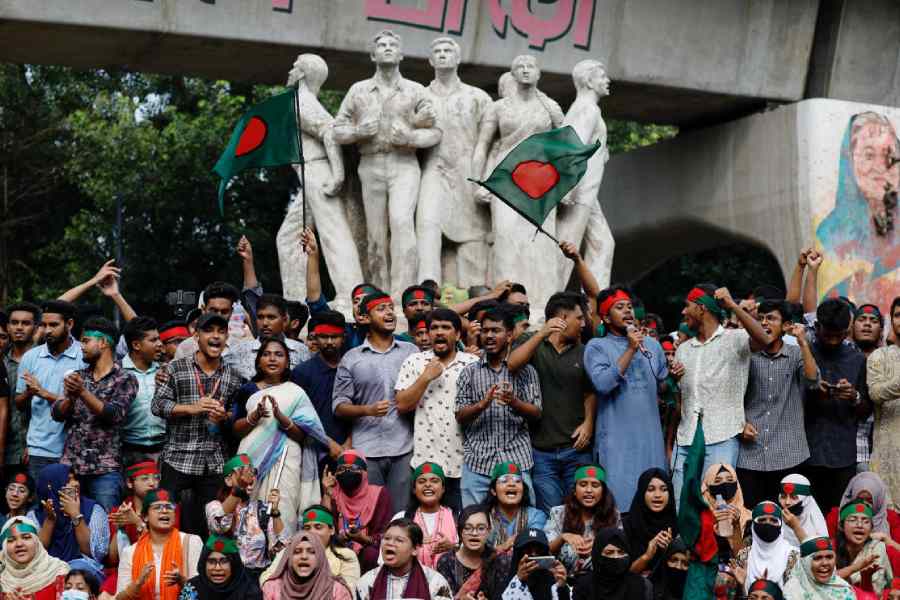Over the last decade, in Bangladesh, Sheikh Hasina Wazed systematically throttled the three main components of the democratic safety valve: regular and free elections, multi-party competition, and civil liberties. Stripping the regime of democratic legitimacy, she opened the door to a popular street uprising, which ultimately coalesced into a revolution.
This diagnosis begs a further question: why has the challenge come from a (non-party centric) student movement?
In 2019, David Jackman, a scholar on Bangladeshi politics, wrote a paper titled “The threat of student movements in Bangladesh: Injustice, infiltrators and regime change”. In the paper, Jackman downgraded the threat posed by the political Opposition and mainstream civil society to regime stability. The former was actively suppressed, “unable to wage the strikes and protests”. The latter, where he includes “prominent newspapers and NGOs”, had been co-opted and, thus, “limited in their ability to voice concerns about the increasing consolidation of power under the ruling party”. Hence, the role of the democratic Opposition in Bangladesh came to be filled by a “resurgence of student movements”, which captured a widely-felt sense of “injustice”.
The quota movement, which toppled Sheikh Hasina, had been fitfully catching sparks for several years. But the specific demand for quotas (concerning a few thousand government jobs) served largely a symbolic purpose. “The [quota] movement,” as Jackson noted in 2019, “grew on the back of simmering discontent around work opportunities for the educated, urban middle class, for whom employment opportunities commensurate to education are perceived to be difficult to find.”
The centrality of student activism in Bangladesh goes back to its conceptualisation as a separate nation. In the 1950s, Dhaka University became a principal site of political ferment over the demand of official status for the Bengali language. Subsequently, the organised force of student bodies played a critical role in transforming the Bengali language movement into a popular national upsurge for separation. The mass uprising of 1969 was initiated by leftist student organisations, mobilising the populace around a radical charter called the Eleven-Point demand (later whittled down by Sheikh Mujibur Rahman to Six Points, principally focused around self-determination).
After Independence, Bangladesh passed through a long spell of civil and military authoritarianism. In the late 1980s, it was student and youth-led mobilisation (particularly by the student wings of the Awami League and the Bangladesh Nationalist Party), once again, which powered the successful ground revolt for the resumption of democracy.
In the first decade of the 21st century, not just Bangladesh but the whole of South Asia seemed to be ambling towards an era of democratic consolidation. In India, Sri Lanka, Pakistan and Bangladesh, political competition had been settling around a stable pattern of two party-led alliance competition, with frequent alternations. The two main parties were roughly presented along the Centre-Left/Centre-Right spectrum: Congress-BJP in India, SLFP-UNP in Sri Lanka, PPP-PML(N) in Pakistan, Awami League-BNP in Bangladesh.
This system of managing State power has been virtually blown apart over the last decade, replaced to varying degrees by electoral authoritarianism. Ruling parties are striving to establish one-party dominance through the subversion of State institutions. The Narendra Modi-led BJP, Mahinda Rajapaksa-led SLFP/SLPP, and Sheikh Hasina-led Awami League adopted variations of a characteristic formula: misuse of security agencies, co-option of mainstream media, and erection of a neo-patrimonial, crony capitalist nexus. Meanwhile, Pakistan has reverted to its familiar pattern of hybrid military-civilian regime.
Popular unrest has now toppled the authoritarian leaders of Sri Lanka and Bangladesh but that hardly translates into a return to democratic health in either case. This is because the crisis of democracy in South Asia is structural in nature. One can term it as the South Asian syndrome: high inequality, party de-institutionalisation, and weakening State capacity. All these factors are intimately connected to one another, forming a doom-loop of democratic decline. Let us take each factor in turn.
First, there is the spiralling inequality. In a standard undergraduate economics course, students are taught about the famous Kuznets curve — the inverse, U-shaped pattern of inequality. In 1955, based on long-term economic data of European economies, Simon Kuznets theorised that as countries developed, income inequality first increased, peaked, and then decreased. As early as 2002, the economists, Daron Acemoglu and James Robinson, conclusively demonstrated that Kuznets curve does not work for “many Latin American and Asian countries”. In Europe, the authors argued, the reduction of economic inequality flowed not from any natural law of economics but from the process of democratisation, specifically the popular pressures brought to bear on ruling elites by mass-based political parties and labour unions. “Democratization leads to institutional changes which encourage redistribution and reduce inequality.”
Why have popular demands for radical reform/redistribution met with elite inaction or indifference in South Asia (apart from paltry giveaways labelled as ‘freebies’)?
For this, we turn to our second factor in the South Asian syndrome — de-institutionalisation of political parties. Party institutionalisation denotes its organisational capacity to channel popular demands, develop a political programme, and implement its political agenda. These functions depend, in turn, on a well-defined mass base, a policy formulating ideological apparatus, and a grassroots activist network. It was the strongly institutionalised parties of Europe (such as the Labour Party in the United Kingdom and the Social Democratic Party in Germany) that waged decades-long, organised, popular struggles, forcing ruling elites to undertake radical socio-economic reform.
In South Asia, however, political parties have proceeded from elite control to elite capture. A scholarly study on Bangladeshi politics observed that the “main political parties like AL, BNP, and JP show increasing similarity in terms of class base and ideology.” It further commented: “party activities such as policy making, decision-making, and committee structuring are centred on the cult of the leader.” This makes for a familiar diagnosis. The state of West Bengal witnessed the metamorphosis of the CPI(M) from a programmatic left-wing party with a strong activist network to an establishment party propped up by a machinery of musclemen and moneyed interests. The same elite interests and strongmen are now firmly embedded within the organisation of the TMC, which itself had started out as a grassroots alternative to the Congress.
This brings us to the last facet of the South Asian syndrome. Why have political parties followed the route of centralised control and populist leadership instead of following the route of stronger institutionalisation and programmatic agenda?
In large measure, this is because of weakened State capacity stemming from the neoliberal shift of the economic structure. In Bangladesh, major free-market reforms were undertaken by the military-led regime and, subsequently, all political parties have been forced to play by the new rules of the game. The earlier arenas of public management (health, education, industrial planning, provision of finance) have now been carved out to either the private sector or globally-connected networks of NGOs. In Bangladesh, NGOs have contributed to limited advances in certain areas. Yet, the benefits imply a critical trade-off in the form of an ever-weakening bureaucratic apparatus.
Without a well-functioning bureaucracy (with its mechanisms for long-term planning and inter-sectoral co-ordination and implementation), South Asian nation-states cannot deliver the structural transformation of the East Asian model (Korea, Japan, Taiwan). Our states remain hard-wired for technocratic tasks, such as managing macro-economic stability, but not for larger, collectivist goals like ensuring jobs for the educated, expanding the middle class, or even providing public goods like health and education.
This moth-eaten ‘public domain’ facilitates only one legitimate contestation — over ethnic-religious identity. Thus, technocratic depoliticisation scorches the political ground for contestations over the nature of the State (among capitalist, socialist and developmentalist alternatives). In its place, a populist ‘re-politicisation’ creates a fertile ground for contestation over the matters of the nation (between secular/communal and ethno-centred/plural alternatives).
The upshot is a political culture of national/religious chauvinism where dissent is criminalised and minorities persecuted. We have seen ample evidence of this in the past few weeks in Bangladesh where Hindu minorities have become scapegoats for
targeted attacks.
Asim Ali is a political researcher and columnist










